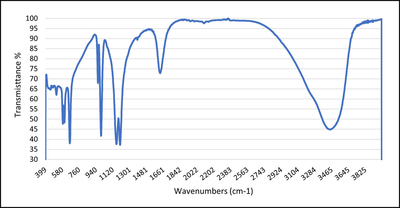Trial to control infectious bursal disease virus using iron oxide chitosan nanocomposite in broiler chickens
Authors: Soad A. Nasef, Mervat A. Ayoub, Karim M. Selim and Dalia M. A. Elmasry
Ger. J. Vet. Res
2022.
vol. 2, Iss. 3
pp:17-27
Doi: https://doi.org/10.51585/gjvr.2022.3.0041

Abstract:
The present study attempted to control infectious bursal disease virus (IBDV) with iron oxide chitosan nanocomposite as an antiviral compound. The iron oxide chitosan nanocomposite was prepared using the co-precipitation method and characterized by high-resolution transmission electron microscopy (HR-TEM) and cytotoxicity assay on Vero cells. To evaluate the effectiveness of iron oxide chitosan nanocomposite against IBDV, eighty 21-day-old Baladi broiler chicks were divided into four groups (G1-G4). Chicks kept in G1 served as a negative control, while chicks kept in G2 (challenged-non-treated) were challenged orally with IBDV 103EID\50/bird). Chicks kept in G3 (challenged-treated) were challenged orally with 1103EID\50 IBDV/bird and received 1 mL of iron oxide chitosan nanocomposite (1 mg dissolved in 100 mL water) for three days post-inoculation (PI) while chicks kept in G4 (non-challenged-treated) received the same dose of iron oxide chitosan nanocomposite for three successive days. The effectiveness of iron oxide chitosan nanocomposite was assessed based on clinical signs, mortalities, postmortem lesions, and viral RNA load in the bursa of Fabricius samples at the 3rd, 6th, and 9th days PI by isolation onto specific pathogen-free embryonated chicken eggs (SPF-ECE) and histopathology. Results revealed that the average particle size of iron oxide chitosan nanocomposite size was found to be 35.1±5 nm. The selected particles exhibited zeta potentials of 16.8±10.9 mV, polydispersity index of 0.91, and iron concentration of 2,625 mg/L. Chicks kept in G2 showed severe clinical signs, including anorexia, ruffled feathers with droopy wings, prostration, and whitish mucoid diarrhea with a mortality rate of 30%. Other groups showed no specific mortalities. The IBDV bursal load was significantly lower (P<0.05) in the challenged-treated chicks (0.5-1 log10) compared to the challenged-non-treated group (3-6.4 log10). Histopathological lesions of the bursa, spleen, thymus, and kidney in the challenged-treated group showed hyperactivity of the lymphoid population compared to necrosis and depletion of lymphoid elements in the challenged control group at the 6th days PI. Based on the current study, iron oxide chitosan nanocomposite showed a promising antiviral activity that could significantly reduce IBDV load in the bursa and decrease pathological changes in lymphoid organs.
Keywords:
IBDV, Broiler chicks, Antiviral, Iron oxide chitosan
Statistics:
Article Views: 2056
PDF Download: 444